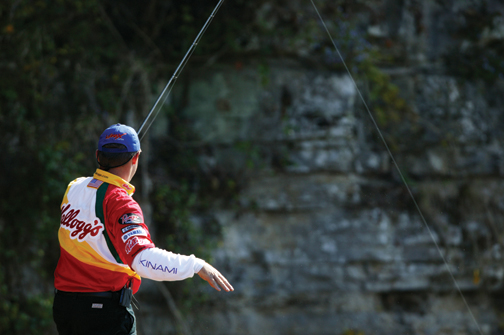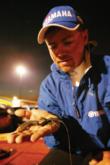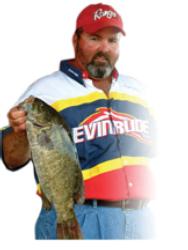Early-season river bass
Once you gain insight into the bass’s reaction to current, things fall into place

“When I saw the current and high water of the Mississippi River, I immediately pondered the wisdom of my decision to compete,” said Kellogg’s pro Dave Lefebre, referring to his experience at the 2001 EverStart Series Northern Division tournament during his rookie season on tour. “In recent years I had become accustomed to fishing impounded water, usually moderately clear to very clear. Suddenly, I’m confronted with high, dingy water and current – lots of current. It was a bit overwhelming.”
But in the spring of 2002, Lefebre returned to the Mississippi River and won the EverStart Series tournament, fishing under flood conditions. He went on that year to earn a spot on the Wal-Mart FLW Tour and to achieve respectable finishes in other river tournaments over the next two seasons.
Give me a break
“It didn’t take a crash course in river fishing to achieve that win,” Lefebre said. “The second time around I was calmer and let my past experiences on flowing water come through. I grew up fishing small bass creeks in Pennsylvania, so I simply had to put the bigger river system into perspective.
“Bass in flowing water behave similarly whether they live in a small stream or a major river system. Locating either smallmouth or largemouth bass is all about current breaks – and finding the right breaks for the time of year and water-level situation. That’s something I learned years ago sloshing around French Creek.”
Lefebre believes water depth is an irrelevant factor when it comes to bass location in a river. “Bass are relatively shallow all the time in rivers,” he said. “Cover is relevant only when it acts as a current break. A current break is a disruption to the normal flow that creates a slack or slower-moving eddy. A current break can be formed by something as small as a single rock or something as large as a wing dam. A break can even be formed by current vectors intercepting at different angles, such as the downstream side of an island.”
On smaller streams where there is basically a single flow, uncovering key current breaks is not complicated. On larger river systems, however, current breaks occur not only on the main river but also in the sloughs, backwater areas and tributary channels.
“There are literally thousands upon thousands of current breaks on a river section,” Lefebre said. “Not all of them hold fish at the same time. The trick is to discover the types of breaks that do hold bass under the given conditions, whether they are on the main channel, secondary flows or backwaters.”
During the spring and early summer, he says it’s generally the breaks in milder currents away from the raging main channel that are especially critical. Later, during the summer and fall, main-channel current breaks play a larger role – especially for smallmouths.
“Early in the season I concentrate on pockets – slack-water cuts or coves – that are protected from a sudden increase in river turbidity yet are adjacent to current,” Lefebre said. “I also focus on `funnels’ – sites where bass must pass to and from backwater pockets. At funnel sites, I target every current-breaking object.”
Having caught smallmouths and largemouths literally side by side from the same areas on river systems in the early season, Lefebre believes both bass species utilize similar areas at this time of the year. One major difference, however, is the precise feeding location in regard to a current break for each species. Largemouths always come from the slack water behind the break. Smallmouths frequently come from the current side of the break, in the buffer or “pillow” area of slack water that forms in front of many irregular-shaped objects.
The love-hate relationship between bass and current is a message that Dion Hibdon of Stover, Mo., stresses, too. Hibdon, like Lefebre, grew up fishing the bass streams of his home state. He transferred that knowledge to larger river systems, which has contributed to tournament victories – including first place at the 2000 FLW Tour Championship on the Red River.
“Bass, both largemouth and smallmouth, love to be positioned near a moving flow because it brings food to them with minimal effort exerted on their part, but they don’t like being positioned in the current because it requires expending too much energy,” Hibdon said. “You always find largemouth bass where the current is broken. They will dart into current to grab something but then slide back to the slack water of an eddy. Largemouths establish their home in the best bank eddies – the biggest tree, the largest rock pile, the fortified sand bar or whatever creates a major break in the current flow. Find the best eddies, and you find the biggest largemouth in a river.
“Smallmouth bass, on the other hand, will endure more current than largemouth, but they can’t keep peddling in the current all the time. They need protection from constant flow, too. However, their still-water sanctuaries will be a lot smaller. A good eddy for a smallmouth may be no larger than the chair you are sitting in right now.”
Hibdon is quick to point out that there are other factors that impact bass location in the early season on a river. Bass likely will be in a prespawn, spawn or postspawn mode.
“Rivers warm slower than lakes within the same geographic region, and therefore river bass will be among the last to spawn,” Hibdon said. “A 2- to 3-degree difference in water temperature from one pocket to the next can be critical because bass will seek out that warmer water. I use my temperature gauge more in the early season on rivers than any other time. Also, when looking for spawning sites, I also consider the bank that has the most sun on it for the longest period of time each day.
“When searching for bass during the pre- through postspawn time frame, it’s important to locate quiet water pockets out of the main river flow. I look for a pocket or cut positioned so it provides the most protection from possible increases to the flow. For example, if the water flow is north to south, I search out dead-end pockets that angle north.”
Heavy spring rains can result in rapid changes in flow rate and water level, sometimes rising several feet overnight. In some cases, a river may recede almost as quickly as it went up. The rise and fall of water level, of course, impacts the positioning of bass.
Lefebre and Hibdon agree that both species of bass at this time of year are bank-bound, staying close to the changing shoreline.
“I rarely find river bass deeper than 4 or 5 feet any time of the year,” Hibdon said. “The clarity of river water does not permit it. Besides, during the spawning period, bass are automatically drawn to the shallows. When the water rises, the deepest that bass will be is where the old shoreline had been. They will hang out for up to a day on a quick water rise before moving toward the new shoreline. It will not take river bass as long as reservoir bass to move shallow and adapt to new surroundings.”
Knowing a bass’s immediate response to rising water is to move shallower has been Lefebre’s mantra for river tournaments. “River bass – both smallmouth and largemouth – relocate to shallower water much faster than bass in lakes when the water goes up,” he said. “The reason is simple. In a rapid rise, the site that had been a slack or eddy suddenly becomes a strong, rushing current. During rising water, I’ll lose individual targets that held fish on the previous day, but I’ll acquire many new targets. As water recedes, bass instinctively fall back to the newly formed current breaks.”
Getting it to the fish
Understanding how bass relate to current is only half of the river-fishing equation. The second part of the equation is current presentations.
If bass are in prespawn mode, Hibdon fishes around shallow cover aggressively with a spinnerbait or a square-lipped crankbait, such as a Timber Tiger. But once bass lock down on cover, he pitches a little jig.
“For rivers, I always go with smaller baits, like a 1/4-ounce jig tipped with a Baby Guido Bug in a crayfish color – a shade of brown or green with some red accent on it,” Hibdon said. “However, if the water color is really dirty, then I’ll go with a black-and-blue combination.”
Following the spawn, Hibdon redirects his focus from protected pockets to eddies where baitfish stack up. He targets hard cover immediately adjacent to current flows with shad-colored tube baits. Using a 1/4-ounce white spinnerbait, Hibdon fishes current edges or “seams” as if they were structure – even if hard cover is not present.
Choice of line size is based on density of cover, water clarity and current. For example, if water clarity is only 6 inches and the cover is dense, his choice would be 17- or 20-pound-test for slack-water areas. But when bass move from the pockets into stronger current situations, he will drop down to 14-, 12- or even 10-pound-test because heavy line does not allow natural presentations in flowing water.
“The majority of prey consumed by river bass is literally floating in the current, and therefore artificial lures must be presented with the flow and with minimal drag,” Hibdon said. “A heavy lure that sinks quickly to the bottom is not natural, nor is a light lure on a heavy line. Lighter line allows a natural drift of smaller baits. Remember, on rivers, lighter is better.”
 For Lefebre, the first presentation that comes to mind for high water on rivers in the spring is flipping and pitching. “There is so much cover to explore – stumps, brush, flooded log jams, and man-made structures not normally underwater,” Lefebre said. “If I could take only one lure to the river with me, it would be a jig.”
For Lefebre, the first presentation that comes to mind for high water on rivers in the spring is flipping and pitching. “There is so much cover to explore – stumps, brush, flooded log jams, and man-made structures not normally underwater,” Lefebre said. “If I could take only one lure to the river with me, it would be a jig.”
The majority of the time in a river situation, Lefebre fishes a small-profile, lightweight jig. His picks include Stanley 5/16- and 3/16-ounce casting jigs, as well as a 5/32-ounce jig of his own design that he has custom-poured. When faced with an exceptionally strong current situation, Lefebre may go to a 9/16-ounce jig.
He trims the skirts short to provide plenty of flare when they contact cover or bump bottom. Jigs are dressed with either small plastic crawdad trailers or chunks. His color combinations are an attempt to match the local crayfish – typically various shades of pumpkin, brown or green with highlights of red or orange. Black on black is his fallback color if the water is exceptionally muddy.
“I always trim the weedguard to within 1/8-inch of the hook point,” he said. “For lake fishing, I also thin the number of strands in the weedguard – but not for river fishing. I want a stiffer weedguard, thereby allowing me to feel my way through cover better while preventing hangups.”
Lefebre stresses the need to cast farther up current so a lighter-weight jig will be on the bottom by the time it reaches the cover or current break. Supporting the same reasoning offered by Hibdon on the need of light line, Lefebre favors 10- to 12-pound fluorocarbon for the lighter-size jigs and 14-pound-test for a 5/16-ounce jig.
A river’s current and rapidly changing water level may impact bass differently than in lakes, but once anglers learn to adapt to flowing water, the signs pointing to bass are easy to read.

